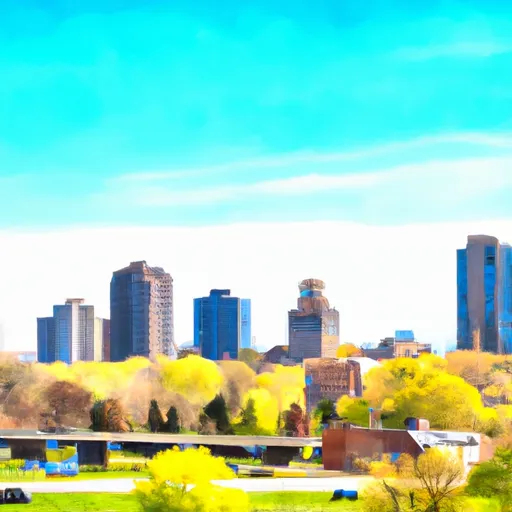-
 Snoflo Premium
Snoflo Premium
Get unlimited access to all our content
With no Ad interruptions! - Start Your Free Trial Login with existing account
River-Grove
Eden Index
Climate
7.8
•
Recreation
4.2
•
Community
3.6
•
Safeguard
5.5/10

River Grove, Illinois is a charming village located in Cook County, just northwest of downtown Chicago. The village experiences a continental climate with four distinct seasons. Summers are warm and humid, with temperatures ranging from 70°F to 90°F. Winters are cold and snowy, with temperatures averaging between 20°F and 40°F. Spring and fall bring mild temperatures and colorful foliage.
Situated along the Des Plaines River, River Grove benefits from its hydrological surroundings. The river serves as a water source and contributes to the village's natural beauty. Additionally, the area has several lakes and ponds, providing additional hydrological features for residents and visitors to enjoy.
Outdoor recreation opportunities in River Grove are abundant. The village boasts numerous parks and green spaces, perfect for picnics, walking, and playing sports. The Des Plaines River offers opportunities for kayaking, canoeing, and fishing. For those seeking more adventure, nearby forest preserves provide hiking and biking trails amidst scenic landscapes.
In conclusion, River Grove, Illinois offers a diverse climate, beautiful hydrological features, and a range of outdoor recreation opportunities, making it an excellent place for nature enthusiasts and outdoor activities.
What is the Eden Index?
The Snoflo Eden Index serves as a comprehensive rating system for regions, evaluating their desirability through a holistic assessment of climate health, outdoor recreation opportunities, and natural disaster risk, acknowledging the profound impact of these factors on livability and well-being.
Climate Health Indicator (CHI): 7.8
River-Grove receives approximately
946mm of rain per year,
with humidity levels near 80%
and air temperatures averaging around
10°C.
River-Grove has a plant hardyness factor of
5, meaning
plants and agriculture in this region thrive during a short period during spring and early summer. Most
plants will die off during the colder winter months.
By considering the ideal temperature range, reliable water supplies, clean air, and stable seasonal rain or snowpacks, the Climate Health Indicator (CHI) underscores the significance of a healthy climate as the foundation for quality living.
A healthy climate is paramount for ensuring a high quality of life and livability in a region, fostering both physical well-being and environmental harmony. This can be characterized by ideal temperatures, reliable access to water supplies, clean air, and consistent seasonal rain or snowpacks.
Weather Forecast
Streamflow Conditions
Upper Illinois
Area Rivers
Upper Illinois
Snowpack Depths
Upper Illinois
Reservoir Storage Capacity
Upper Illinois
Groundwater Levels
Recreational Opportunity Index (ROI): 4.2
The Recreational Opportunity Index (ROI) recognizes the value of outdoor recreational options, such as parks, hiking trails, camping sites, and fishing spots, while acknowledging that climate plays a pivotal role in ensuring the comfort and consistency of these experiences.
Access to outdoor recreational opportunities, encompassing activities such as parks, hiking, camping, and fishing, is crucial for overall well-being, and the climate plays a pivotal role in enabling and enhancing these experiences, ensuring that individuals can engage in nature-based activities comfortably and consistently.
Camping Areas
| Campground | Campsites | Reservations | Toilets | Showers | Elevation |
|---|---|---|---|---|---|
| Oblong Park | None | 491 ft | |||
| Bumpus Mills - Lake Barkley | None | 520 ft | |||
| Piney - LBL | 300 | 385 ft | |||
| Rushing Creek - LBL | 56 | 402 ft | |||
| Red Hills Lake State Park | 130 | 519 ft | |||
| Boswell Landing | 34 | 406 ft | |||
| Robinson City Park | None | 541 ft | |||
| Gatlin Point - LBL | 19 | 453 ft | |||
| Crawford County Fairgrounds | None | 508 ft | |||
| Gatlin Point | 30 | 433 ft |
Nearby Ski Areas
Catastrophe Safeguard Index (CSI):
The Catastrophe Safeguard Index (CSI) recognizes that natural disaster risk, encompassing floods, fires, hurricanes, and tornadoes, can drastically affect safety and the overall appeal of an area.
The level of natural disaster risk in a region significantly affects safety and the overall livability, with climate change amplifying these risks by potentially increasing the frequency and intensity of events like floods, fires, hurricanes, and tornadoes, thereby posing substantial challenges to community resilience and well-being.
Community Resilience Indicator (CRI): 3.6
The Community Resilience Indicator (CRI) recognizes that education, healthcare, and socioeconomics are crucial to the well-being of a region. The CRI acknowledges the profound impact of these elements on residents' overall quality of life. By evaluating educational resources, healthcare accessibility, and economic inclusivity, the index captures the essential aspects that contribute to a thriving community, fostering resident satisfaction, equity, and social cohesion.

